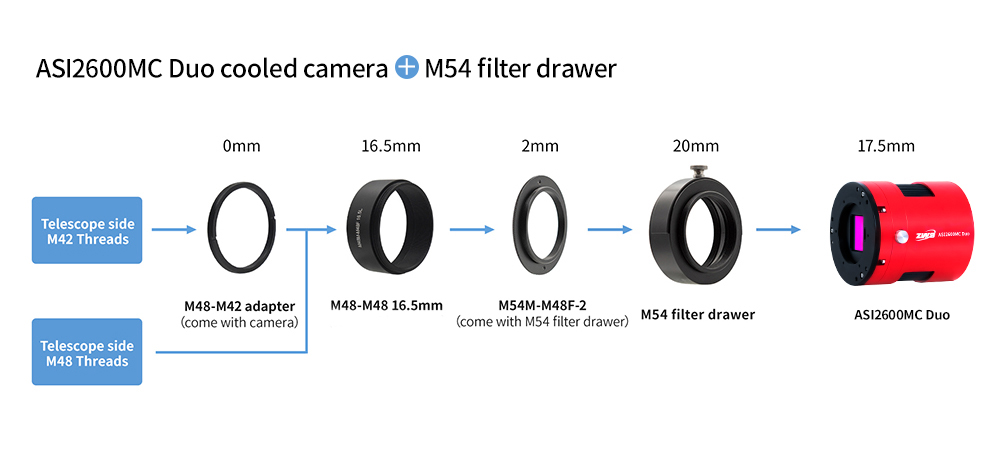About this product
Model: zwo_asi2600mm_duo
Part Number: ASI2600MM-DUO
ZWO ASI 2600MM Pro DUO USB 3.0 Cooled Mono Astronomy Camera - First Batch due in April 2024
The ASI2600MM Pro DUO is the monochrome version of the popular ASI2600MC Pro DUO and uses Sony’s latest back-illuminated IMX571 APS-C format native 16-bit ADC sensor.
Features include ultra-high 14 stops dynamic range, very low 1.0e readout noise and zero amp-glow!
APS-C format:
The Sony 26 MP APS-C format sensor with 3.76um pixels provides a large well depth of 50ke.
The main sensor length and width are 23.5mm x 15.7mm, and the diagonal is 28.3mm.
Two-in-one design
Thanks to the compact design, the ASI2600MM DUO only needs one USB cable for control. It reduces potential cabling issues and improves setup speeds. You don’t need a separate OAG and guide camera.
The guide sensor is the Type 1/1.8 SC2210 with excellent NIR sensitivity. The sensor size is 7.68mm x 4.32mm. It has 4umx4um pixels with an array of 1920x1080 and a full depth of 8780e.

All ZWO cameras include a 2-year warranty.
FEATURES
- Sony IMX571 Sensor
- 6248x4176 3.76 μm Pixels
- 512MB DDR3 Memory Buffer
- Zero Amp Glow!
- Regulated two-stage Tec-Cooling: 35 degrees below ambient temperature
- Extremely low read noise - 1.0-3.3e
- 16Bit ADC - provides real 16bit dynamic range
- Electronic shutter - no issues with vibrations sometimes found in mechanical shutters
- USB3.0 Port (back compatible with USB2.0)
- AR (anti-reflective) protective window
- Back Focus: 17.5mm (standard) or 12.5mm (without tilt plate)
- Compatible with Windows / Mac OS / Linux
- Guide Sensor: SC2210 - 7.68 x 4.32mm
- Guide Sensor: 12 Bit ADC

Native 16bit ADC
As one of the few CMOS astronomy cameras with 16-bit ADC in the market, ASI2600MM Pro DUO is perfect for astrophotography. This 16-bit ADC is not a CCD 16-bit ADC. It can achieve a dynamic range output of 14 stops, significantly improving the image's sharpness and contrast and creating smoother and more natural colour transitions.

Tilt Adjustment from Rear (Optional)
The 3 points from the rear make tilt adjustment much easier without the trouble of removing the tilt plate from the camera.

IMX571 backlit sensor
Sony’s back-illuminated CMOS image sensor improves sensitivity and noise reduction – the key factors to enhancing image quality, while radically realigning their fundamental pixel structure from front-illumination to back-illumination. It has retained the advantages of CMOS image sensors, such as low power consumption and high-speed operation.
With a conventional front-illumination structure, the metal wiring and transistors on the silicon substrate surface that form the sensor’s light-sensitive area (photo-diode) impede photon gathering carried out by the on-chip lens. A back-illuminated structure minimises the degradation of sensitivity to optical angle response while also increasing the amount of light that enters each pixel due to the lack of obstacles, such as metal wiring and transistors that have been moved to the reverse of the silicon substrate.
Sony has newly developed a unique photo-diode structure and on-chip lens optimised for back-illuminated structures that achieve higher sensitivity and a lower random noise without light by reducing noise, dark current and defect pixels compared to the conventional front-illuminated structure.

DDR Memory Buffer
ZWO Pro DUO cameras feature a 512MB DDR3 memory buffer to enable data transfer stability and reduced amp-glow caused by the slow data transfer speed when using a USB 2.0 port.
Camera Field of View Simulator
Camera Performance
The ASI2600MM Pro DUO has excellent performance with a dynamic range of up to 14 stops. When the gain value is 100, the magical HCG high gain mode is turned on, the readout noise is significantly reduced, and the dynamic range is basically unchanged. For better data quality, it is recommended to set the gain to 0 or gain 100 during deep-sky imaging.

QE Curve
According to the test results from Sony, the QE peak value of the ASI2600MM Pro DUO is 91%.

Zero Amp Glow
Traditional CMOS sensors produce a weak infrared light source during operation, often seen in the corner of uncalibrated images as the telltale signs of ‘amp glow’. As the ASI2600MM Pro DUO uses zero amp glow circuitry, you won’t have to worry about amp glow even when using high gain, long exposure imaging.
With amp glow – exposure 300-second exposure:

ASI2600 frame with no amp glow – Exposure 300 seconds:

Anti-dew
A polyimide heater completely fits the protective window in the ASI2600MM Pro DUO camera. It can help avoid the annoying dew or icing issues.
The power of the heater is around 5W. You can turn it off anytime in your photography software to save some power.
(Image shown ASI2600MM Pro)

Two-stage TEC cooling, ultra-low dark current
Thanks to the two-stage TEC cooling, ASI2600MM Pro DUO can lower the CMOS sensor temperature to more than 35c below ambient, significantly reducing dark current generation and sensor noise even with extended exposure times.
The unique dark current suppression technology can even further reduce dark current noise. At a cooling temperature of 0 °, the dark current noise is only 0.0022e/s/pix. This means 300s exposure can only cause 0.7e dark current noise, which is less than the readout noise. While at a cooling temperature of -20 °, the dark current can even reduce to 0.00012e/s/pix, which is negligible!

Comparison
| | ASI2600MM Pro | ASI2600MM-Duo |
| Sensor | IMX571 | IMX571/SC2210 |
| Max FPS | 3.51FPS | 15FPS (RAW 8) |
| Full Well | 50Ke | 73Ke at Gain -25 |
| Adapter | M42 x 0.75 | M54 x 0.75 |
| Guiding | Not Supported | Supported |

What's in the box

Customer reviews
FAQ
Please fill in the form below to ask a question.